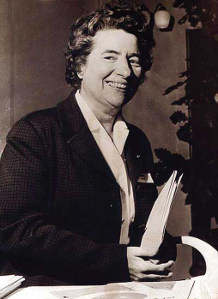Marguerite Perey facts for kids
Quick facts for kids
Marguerite Perey
|
|
|---|---|
 |
|
| Born | 19 October 1909 Villemomble, Seine-Saint-Denis, France
|
| Died | 13 May 1975 (aged 65) Louveciennes, Yvelines, France
|
| Alma mater | The Sorbonne |
| Known for | Francium discovery |
| Awards | Leconte Prize (1960) |
| Scientific career | |
| Fields | Physics, chemistry, radiochemistry |
| Institutions | Curie Institute, University of Strasbourg |
| Influences | Marie Curie |
Marguerite Catherine Perey (born October 19, 1909 – died May 13, 1975) was a brilliant French physicist. She was also a student of the famous scientist Marie Curie. In 1939, Marguerite Perey made an amazing discovery: she found a new chemical element called francium. She did this by carefully cleaning samples of other elements. In 1962, she became the first woman ever chosen to join the French Académie des Sciences. This was a huge honor, even bigger than what her teacher Marie Curie received. Sadly, Perey passed away from cancer in 1975.
Contents
Early Life and Education
Marguerite Perey was born in 1909 in Villemomble, France. This town is just outside Paris, where the famous Radium Institute was located. Marguerite wanted to study medicine. However, her father's death caused financial problems for her family.
In 1929, Perey earned a chemistry diploma. She got it from Paris' Technical School of Women's Education. This diploma allowed her to work as a chemistry technician. That same year, at just 19 years old, Perey applied for a job. She became a personal assistant to Marie Curie at the Radium Institute in Paris. Marie Curie became her mentor and guided her work.
Working with Marie Curie
Under Marie Curie's guidance, Perey learned many skills. She learned how to separate and clean radioactive elements. Her main focus was on the element actinium. This element was discovered in Curie's lab in 1899.
Perey spent ten years carefully separating actinium. She removed it from all the other parts of uranium ore. Marie Curie then used this pure actinium for her studies. Marie Curie died in 1934, just five years after Perey started working with her. But Perey continued her important research on actinium. She was promoted to radiochemist.
Discovering Francium
In 1935, Perey read a science paper. American scientists claimed they found a type of radiation from actinium. This radiation was called beta particles. Perey was doubtful because the energy of these particles didn't seem right for actinium.
She decided to investigate the mystery herself. Perey thought that actinium might be changing into another element. She believed this "daughter atom" was actually producing the beta particles. She proved her idea by getting very pure actinium. She then quickly studied its radiation. She found a small amount of alpha radiation. Alpha radiation means an atom loses protons. This changes the atom's identity. If actinium (element 89) lost an alpha particle, it would become element 87. This element had never been seen before!
Perey announced her discovery on January 9, 1939. It was presented at the Académie des Sciences. The paper was titled "On an element 87, derived from actinium." Jean Baptiste Perrin announced it, not Perey herself. This was because she was only a lab assistant without a university degree. Perey named the new element francium, after her home country, France. Francium is the rarest element on Earth. Only about 550 grams exist in the entire Earth's crust. It was also the last element found naturally in nature.
Later Career and Achievements
After her discovery, Perey received a grant. She went to study at Paris' Sorbonne University. Since she didn't have a bachelor's degree, she had to take extra courses. She needed to earn the equivalent of a B.S. degree. Only then could she start her PhD program. She earned her Doctorate of Physics from the Sorbonne in 1946.
After getting her PhD, Perey returned to the Radium Institute. She worked there as a senior scientist until 1949. In 1949, Perey became the head of nuclear chemistry. This was at the University of Strasbourg. There, she developed the university's radiochemistry program. She also continued her research on francium.
She founded a laboratory that became the Laboratory of Nuclear Chemistry in 1958. She was also the director of this lab. Perey was a member of the Atomic Weights Commission from 1950 to 1963.
Marguerite Perey was nominated five times for a Nobel Prize. However, she never received it. Sadly, Perey developed bone cancer. This was likely due to her work with radioactive elements. She had hoped francium could help diagnose cancer. But it turned out to be cancer-causing itself. Perey died on May 13, 1975, at age 65. She is remembered for pushing for better safety rules for scientists working with radiation.
Honors and Recognition
Marguerite Perey received many honors for her important work.
- In 1950, she received the Wilde Prize from the French Academy of Science.
- In 1960, she won the Le Conte Prize from the French Academy of Science.
- She also received the City of Paris Science Grand Prize in 1960.
- In 1960, she was made an Officier of the Légion d'Honneur.
- In 1962, she was elected to the Académie des Sciences in Paris. This was a huge moment! She was the first woman ever elected to the Académie since it started in 1666. However, she was a "corresponding member," which meant she had limited privileges.
- In 1964, she received the Lavoisier Prize from the Académie des Sciences.
- She also got the Silver Medal from the Société Chimique de France in 1964.
- In 1974, she was made a Commandeur of the Ordre National du Mérite.
Images for kids
See also
 In Spanish: Marguerite Perey para niños
In Spanish: Marguerite Perey para niños


